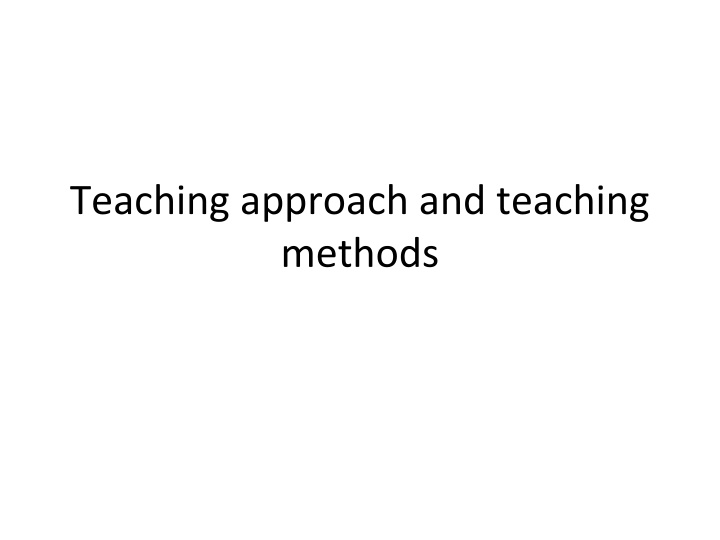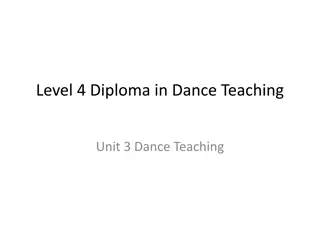Effective Teaching Approaches and Methods for Educators
Characteristics of good teaching include being sensitive to students' abilities and needs, using effective teaching methods, and integrating interactive teaching approaches. Teachers should structure their teaching in relation to students, be familiar with the curriculum, and develop methods that encourage experiential learning. Terminologies such as teaching approach, strategy, and method are essential for guiding educators in creating engaging and impactful learning experiences. Interactive teaching involves active student participation, discussions, and hands-on experiences using teaching aids. Various teaching methods like lectures, demonstrations, role-play, problem-based learning, and ICT integration offer diverse ways to engage learners effectively.
Download Presentation

Please find below an Image/Link to download the presentation.
The content on the website is provided AS IS for your information and personal use only. It may not be sold, licensed, or shared on other websites without obtaining consent from the author.If you encounter any issues during the download, it is possible that the publisher has removed the file from their server.
You are allowed to download the files provided on this website for personal or commercial use, subject to the condition that they are used lawfully. All files are the property of their respective owners.
The content on the website is provided AS IS for your information and personal use only. It may not be sold, licensed, or shared on other websites without obtaining consent from the author.
E N D
Presentation Transcript
Teaching approach and teaching methods
Characteristics of Good teaching In order to ensure that you are teaching well, as a teacher, should structure your teaching in relation to Your students: you should be sensitive to your students ability, interest and needs. This motivate them to learn better Curriculum: Ensure that you are thoroughly familiar with what you are required to teach, Help your students to make sense of what they are learning, encourage the creativity ability of each student
Characteristics of Good teaching Teaching method: You should develop teaching method that: Build on foundation of knowledge already possessed by students Encourage students to learn by doing Ensure that learning grows out of useful experience and experimentation Using teaching aid effectively Vary grouping of students so as to get the most efficient learning Stimulate appreciation as well as cognitive development (How children learn at different stages and therefore, how the need to be taught, how to select teaching materials and methods appropriate to the age and ability of students
Terminologies Teaching approach: It is set of principles, beliefs, or idea about the nature of learning which is translated into the classroom Teaching strategy: Is a long term plan of action designed to achieve a particular goal Teaching method: It is a systematic way of doing something. Implies on orderly logical arrangement of steps. It more procedural. Can be classified as interactive and less interactive Interactive teaching is a means of instructing whereby the teachers actively involve the students in their learning process by way of regular teacher-student interaction, student-student interaction, use of audio-visuals, and hands- on demonstrations. The students are constantly encouraged
Interactive Teaching Involves facilitator and learners Encourage and expect learners to participate Use questions to stimulate discussion, emphasizing the value of answers Give participants hands-on experience Use teaching aids to gain and retain attention
Teaching methods Lecture/ presentations method Demonstration method Simulation/Role play/Drama method Lecture with discussion Problem based learning brainstorming Project based learning Guest speaker Field Trip Online learning Blended learning Cooperative learning Game Attachments Preparation Which are the best for teaching ICT? Strengths Weaknesses
Choice of teaching method ..things to consider Nature of the topic/subtopic Level of Class Leaner needs, capabilities Topic expectation Surrounding Environment (Ex. Weather of the day and) Time you have for particular lesson Size of the class Resources: this will determine the final selection of methods to be used, since there is no point choosing methods which cannot be implemented Competence to developed
Cooperative Learning (CL) Is the instructional use of small group through which students work together to maximize their own and each other s learning. In cooperative groups, each member has a valued role in the learning process and everyone is responsible for each other's learning
What is Cooperative learning ? Cooperative learning, is also called collaborative learning, occurs whenever students interact in pairs or groups to share knowledge and experiences. All activities in which students work together head towards a common goal, from interacting with daily partners to completing long term projects with learning communities, are cooperative learning activities.
Cooperative learning is a method of teaching and learning in which students team together to explore a significant question or create a meaningful project. In cooperative learning, students work together in small groups on a structured activity. They are individually accountable for their work, and the work of the group as a whole is also assessed. Cooperative learning is a successful teaching strategy in which small teams, each with students of different levels of ability, use a variety of learning activities to improve their understanding of a subject. Each member of a team is responsible not only for learning what is taught but also for helping teammates learn.
Five (5) Component/Elements of CL 1-Positive interdependence (a sense of sink or swim together) 2.Face-to-face - promotive interaction 3.Individual and group accountability (each of us has to contribute and learn), 4-Interdependence and small group skills (communication, trust, leadership, decision making, and conflict resolution), 5.Group processing (reflecting on how well the team is functioning and how to function even better).
Elements of Cooperative Learning 1-Positive Interdependence (sink or swim together) Each group member's efforts are required and indispensable for group success . Each group member has a unique contribution to make to the joint effort because of his or her resources and/or role and task responsibilities.
2. Face-to-Face Interaction (promote each other's success) Orally explaining how to solve problems Teaching one's knowledge to other Checking for understanding Discussing concepts being learned Connecting present with past learning
3. Individual &Group Accountability Keeping the size of the group small. The smaller the size of the group, the greater the individual accountability may be. Giving an individual test to each student. Randomly examining students orally by calling on one student to present his or her group's work to the teacher (in the presence of the group) or to the entire class. Observing each group and recording the frequency with which each member-contributes to the group's work. Assigning one student in each group the role of checker. The checker asks other group members to explain the reasoning and rationale underlying group answers. Having students teach what they learned to someone else.
4. Interpersonal (social) &Small-Group Skills Social skills must be taught in order to successful cooperative learning to occur: Decision-making Trust-building Leadership Communication Conflict-management skills
5. Group Processing Group members discuss how well they are achieving their goals and maintaining effective working relationships Describe what member actions are helpful and not helpful Make decisions about what behaviors to continue or change.
Roles are assigned in a cooperative group. LEADER RECORDER CHECKER Timer OBSERVER
CHECKER -makes sure that everyone in the group understands all the material -ensures that everyone in the group is prepared to make their part of the presentation.
LEADER -responsible for the groups output -keeps group on track and focused -assigns tasks -controls the direction of the project -assigns additional roles, such as experimenter or equipment manager
RECORDER -takes notes for the team -responsible for compiling and presentation of final product -gets supplies for team when necessary
OBSERVER/READER -makes sure that everyone in the group is contributing (no sponges!) -ensures that everyone in the group has an equal opportunity to speak. -makes sure that all comments are positive. -reads material to the group.
Types of CL Formal CL is structured, facilitated and monitored by the educator over time and is used to achieve group goals in task. JIGSAW Assignment that involve group problem solving and decision making Laboratory assignment
Formal CL Formal groups- -Designed for students to have enough time to thoroughly complete an academic assignment -May last several days or weeks. -Design tasks to include: Positive interdependence Group processing Face to face promotive interaction Individual and group accountability Social and Interpersonal Skills
Informal CL Informal CL incorporate group learning with passive teaching by drawing attention to material through small groups throughout the lesson or by discussion at the end of lesson and typically involves group of two (Eg turn to your partner discussion)facilitated and monitored by the educator over time and is used to achieve group goals in task. Eg Think-pair-share
Informal CL Informal groups: They are temporary groups that last for only one discussion or one class period. Their purposes are to focus student s attention on the material to be learned, set a mood conducive to learning, help organize in advance the material to be covered in a class session, ensure that students cognitively process the material being taught, and provide closure to an instructional session. They may be used at any time, but are especially useful during a lecture or direct teaching ,Can last a few minutes or class period . Examples: A-Summarize the answer to the question being discussed. b. Solve a problem. c. Give a reaction to a theory, a concept, or information being presented. d. Elaborate (relate material to past learning so that it gets integrated into existing conceptual frameworks) the material being presented. e. Predict or explain. f. Attempt to resolve the conceptual conflict the presentation has aroused. g. Hypothesize answers to the question being posed.
Types Based group learning(eg long term study group): Is effective for learning complex subject matter over the course, term or semester and established caring, supportive peer relationships, which in turn motivates and strengthens the student s commitment to the group s education while increasing self-esteem and self-worth. Based group approaches also make the students accountable to educating their peer group in the event that a member was absent for a lesson. This is effective both individual learning as well as social support.
Base groups Created to provide students support throughout a semester or academic year Results: general sense of belonging to class The base group functions as a support group for its members that: Gives assistance, support, and encouragement for mastering the course content and skills and provides feedback on how well the content and skills are being learned. Gives assistance, support, and encouragement for thinking critically about the course content, explaining precisely what one learns, engaging in intellectual controversy, getting the work done on time, and applying what is learned to one's own life. Provides a set of interpersonal relationships to personalize the course and to try out the cooperative learning procedures and skills emphasized within the course. Provides a structure for managing course evaluation
Cooperative learning techniques Think-pair-share Jigsaw Jigsaw II Reverse Jigsaw Inside-outside circle etc
More Examples of cooperative learning Peer tutoring, Conversation cards, Think-pair- share, Role-plays Jigsaw, Open-ended free conversations , Information-gap activities, Problem solving, Storytelling, Cooperative projects, Paired interviews, Sharing opinions, debating, narrating, describing, and explaining.
The more students work in cooperative learning groups: The more they will learn The better they will understand what they are learning The easier it will be to remember what they learn The better they will feel about themselves, the class and their classmates. Other outcomes Positive relationships, and psychological health. Higher achievement and greater productivity More caring, supportive, and committed relationships Greater psychological health, social competence, and self esteem. Acknowledgment of individual differences Interpersonal development Active involvement in learning More opportunities for personal feedback
Deeper understanding of content Increased overall achievement in grades Improved self-esteem Higher motivation to remain on task Active and constructive involvement in content Ownership of their own learning Solving group conflicts Improvement of teamwork skills Increased student retention Enhancement of student satisfaction with their learning experience Development of skills in oral communication Development of students' social skills
Jigsaw The cooperative learning strategy known as the "jigsaw" technique helps students create their own learning. Teachers arrange students in groups. Each group member is assigned a different piece of information. Group members then join with members of other groups assigned the same piece of information, and research and/or share ideas about the information. Eventually, students return to their original groups to try to "piece together" a clear picture of the topic at hand. That's the simple overview. The resources below will fill in the details and provide examples of the technique in action.
Jigsaw The jigsaw classroom is a research-based cooperative learning technique invented and developed in the early 1970s by Elliot Aronson and his students at the University of Texas and the University of California. Since 1971, thousands of classrooms have used jigsaw with great success. The Jigsaw Classroom is a cooperative learning technique that reduces racial conflict among school children, promotes better learning, improves student motivation, and increases enjoyment of the learning experience.
Jigsaw classroom in 10 Easy Steps: Divide students into 5- or 6-person jigsaw groups (home groups). The groups should be diverse in terms of gender, ethnicity, race, and ability. Appoint one student from each group as the leader. Divide the day's lesson into 5-6 segments. For example, if you want ICT students to learn about Computer evolution, Then, students will move from jigsaw groups (home groups) to expert groups, depending on the segment they work. Students spend time to read over their segment at least twice and become familiar with it.
Jigsaw classroom in 10 Easy Steps: Give students in these expert groups time to discuss the main points of their segment and to rehearse the presentations they will make to their jigsaw group (home group). Bring the students back into their jigsaw groups. Ask each student to present her or his segment to the group. Encourage others in the group to ask questions for clarification. Each home group make a presentation about the topic.
Questions Q & A























